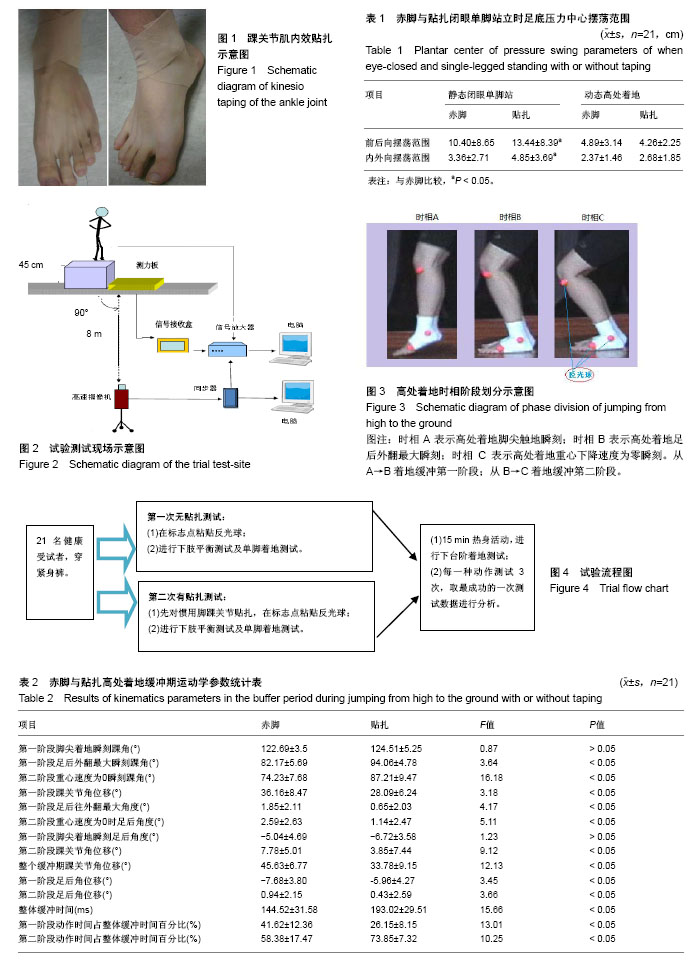中国组织工程研究 ›› 2018, Vol. 22 ›› Issue (19): 3014-3020.doi: 10.3969/j.issn.2095-4344.0291
• 骨与关节生物力学 bone and joint biomechanics • 上一篇 下一篇
踝关节贴扎后人体平衡及高处着地缓冲能力的生物力学分析
石 玉1,廖永华2,罗 炯3
- 1成都中医药大学体育学院,四川省成都市 611137;2电子科技大学体育部,四川省成都市 611731;3西南大学体育学院,国家体育总局体质评价与运动机能监控重点实验室,重庆市 400715
Biomechanical analysis of human balance and buffer capacity of ankle joint when dropping from height after taping
Shi Yu1, Liao Yong-hua2, Luo Jiong3
- 1College of Physical Education, Chengdu University of Traditional Chinese Medicine, Chengdu 611137, Sichuan Province, China; 2Department of Physical Education, University of Electronic Science and Technology of China, Chengdu 611731, Sichuan Province, China; 3College of Physical Education, Southwest University, State Key Laboratory of Physical Fitness Evaluation and Sports Function Monitoring, Chongqing 400715, China
摘要:
文章快速阅读:
.jpg)
文题释义:
肌内效贴扎:肌内效贴最早由日本人加濑建造博士所创,现经过多年发展,肌内效贴的贴布材质、贴扎技术得到不断改进。它最常被运动员在训练过程或比赛中,通过贴扎人体不同部位来达到保护相应关节、肌肉、韧带组织之目的。目前贴扎在欧美、中国台湾及中国香港等地区的运动医学界同样得到了广泛应用。
贴扎方法:非弹性材质贴扎方法(即俗称白贴):先作前后两端的环状固定,之后以编篮式的贴法完成马镫及马蹄贴扎,随后进行8字型贴扎,之后作内外侧锁跟,其后在贴扎的两端点作环状贴扎结束。弹性材质贴扎方法(即肌内效贴布):先将肌内效贴布从前脚掌中间拉长粘贴到胫前肌胫骨前方突起处,第2条贴布以马镫型方式将贴布从后脚跟包裹住脚踝向上贴到第1条贴布侧面,第3条贴布绕过脚踝前方及中间和后面,第四条贴布轻微拉紧从足弓向上通过脚踝中间和后方4-6英尺。
摘要
背景:基于先前研究,踝关节贴扎能增加踝关节稳定度,对踝关节扭伤具有预防效果,故目前穿戴踝关节护具或使用踝关节贴扎已被运动选手及普通大众在运动训练、比赛及健身活动中广泛采用。但极少有文献能从运动学、动力学角度去完整探讨踝关节贴扎用于运动伤害预防时是否可能发生其他不良反应。
目的:探讨踝关节贴扎前后对健康年轻人平衡能力及高处着地缓冲能力影响的机制,为运动员或一般喜好运动的民众如何使用贴扎树立正确观念,从而为避免运动伤害及增进运动表现提供参考。
方法:共招募21位健康受试者,使用高速摄像、三维力测力板评测贴扎前后受试者静态平衡及高处着地时的动态平衡、地面反作用力及下肢负荷率。并应用重复测量方差方法对相关指标进行统计学处理。
结果与结论:①贴扎对高处着地动作的瞬刻踝关节跖屈角度及足后角度无影响,但贴扎能有效限制足后外翻最大角度及重心速度降至为零时的足后角度;②贴扎能明显缩小着地缓冲期第一、第二阶段踝关节角位移及足后动作角位移,显著延长缓冲时间,明显缩短了第一阶段占整体缓冲时间百分比;③贴扎显著影响闭眼单脚站立表现,增加了压力中心摆荡幅度,但对高处着地动态平衡能力似乎无影响;④贴扎后高处着地时,垂直地面反作用力最大值出现时间呈显著缩短,垂直冲击力峰值呈下降现象,但冲击力负荷速率显著增加;⑤结果表明,踝关节贴扎会改变受试者着地形态,有效限制足后外翻最大角度,降低足后及踝关节角位移,对增强高处着地的动作稳定性有一定功效;踝关节贴扎对动、静态平衡能力的影响程度及机制有待于深入探讨,但贴扎显著缩短了地面反作用力最大值出现的时间,从而导致作用力负荷速率显著增加,故可能增加了下肢关节受伤的风险。
中国组织工程研究杂志出版内容重点:人工关节;骨植入物;脊柱;骨折;内固定;数字化骨科;组织工程
ORCID: 0000-0002-3074-2625(石玉)
中图分类号:


.jpg)